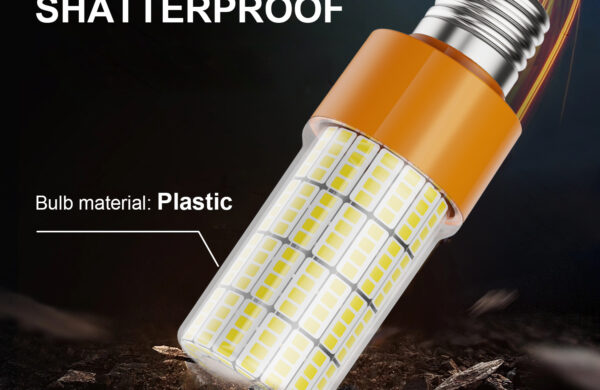LED lamp Compared with energy-saving lamps, LEDs are more energy-efficient.
The energy consumed by LED lamp is 25% of that of energy-saving lamps. This is because ordinary energy-saving lamps still consume part of the electrical energy to convert into heat, while LED lamps do not have this problem. The service life of LED lamps is longer, and the service life of qualified LED bulbs can reach 10,000 to 20,000 hours, while the service life of the same energy-saving lamp is between 6,000 and 10,000 hours.
LED lights are more environmentally friendly. Mercury is one of the indispensable luminescent materials for energy-saving lamps. As the time of use increases, there will be gaps in the sealing of energy-saving lamps, and the mercury in it will volatilize into the air, causing air pollution. LED lights have no such problems at all, and are safe and environmentally friendly. LED lights far exceed energy-saving bulbs in anti-vibration and lightning protection performance. Continuous switching caused by voltage instability has far less impact on LED lamps than energy-saving lamps.
If the energy-saving lamps are switched on and off frequently, the service life will be greatly reduced. At present, a major reason that hinders the promotion of LEDs is that the price is too expensive. For ordinary users, the performance of service life, energy saving and environmental protection cannot be directly observed after all, and only the price can be intuitively felt. However, considering the advantages of the above LED lights, the cost of installation is acceptable. After all, the service life is so long, and it is stable and not easy to break. In the long run, it is definitely more cost-effective than buying energy-saving lamps.
How to identify the pros and cons of LED energy-saving lamps
LED energy-saving lamps are becoming increasingly popular with consumers because of their obvious power-saving effects, long service life, no stroboscopic effect, no noise, and soft light and wide working voltage range. However, there are many LED energy-saving lamps on the market, with varying quality. How to choose the products you are satisfied with from the dazzling array of energy-saving lamps in the lighting store? The advantages and disadvantages of energy-saving lamps can be identified through the “five look”, which are introduced as follows.
Take a look at packaging and trademarks
The state mandates that LED lighting manufacturers’ products mark the following on the outer packaging: rated voltage, voltage range, rated power, and rated frequency. Generally speaking, the trademarks of high-quality products have good printing quality, clear fonts, and are not easy to fall off. Wipe them with a soft damp cloth. The signs are clearly identifiable and difficult to wipe off. They have the manufacturer’s trademark and related certification marks. Fake and inferior products have poor printing quality, blurred fonts, easy erasure, and no manufacturer’s trademark and related certification marks.
Second look at the appearance of the LED tube
The real LED energy-saving lamps are made of tricolor tubes, which are white, and they are whiter by covering them with hands. In addition, from the point of view of the lamp tube, multiple lamps can be put together for comparison. The shape and size of the lamp tube are more consistent with the machine bending, and most of them are mass-produced products. The consistency of the product is good, the quality is easier to be guaranteed, and the interchangeability during maintenance is better. Of course, there should be no cracks, looseness, and traces of prying between the interfaces. During installation and disassembly, the lamp cap should not be loose or tilted.
The plastic shell of the lamp must be of the flame-retardant type of engineering plastic. Ordinary plastics are easily deformed and flammable, and are prohibited from being used in the production of energy-saving lamps. The two can be easily distinguished from the surface. The latter has a smoother and shiny surface, and the former has a texture similar to frosted glass.
LED does not contain toxic substances; the fluorescent tube energy-saving lamp breaks during operation and will leak toxic mercury vapor.
In terms of color rendering, both LED and fluorescent tube energy-saving lamps can achieve above 0.9. The spectral characteristics of the two are slightly different, but the color rendering of low-cost LED lamps is worse than that of fluorescent tube energy-saving lamps.
LED lighting sources are often integrated with lamps. Therefore, considering the overall price factors, high-efficiency fluorescent tubes are more suitable for energy-saving lamps above 20W; LED lamps are appropriate for those below 20W. Ordinary fluorescent tube energy-saving lamps below 20W still have a price advantage. The night light below 2W is already non-LED.




